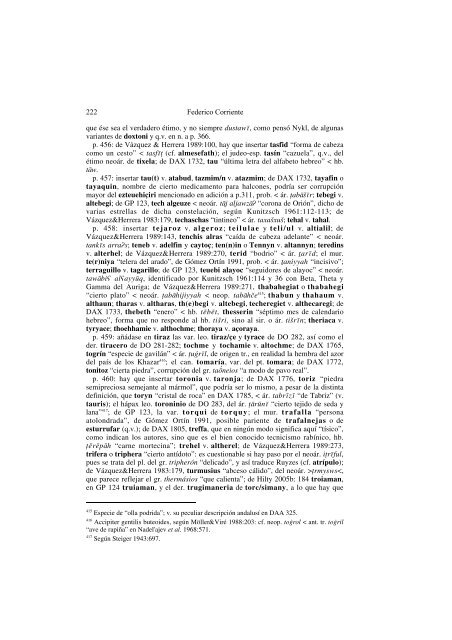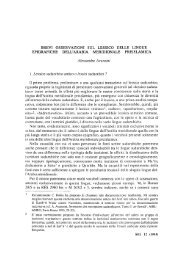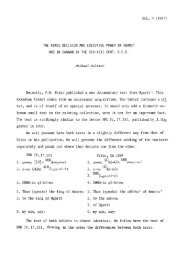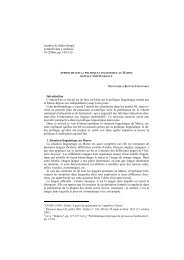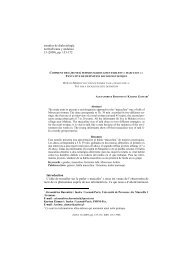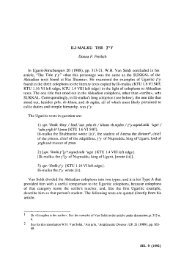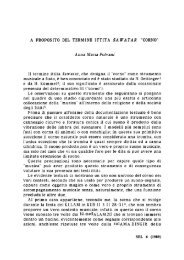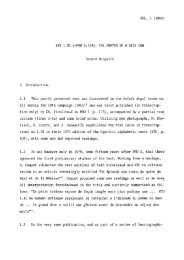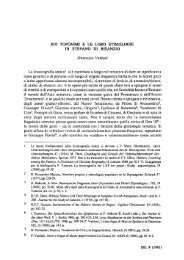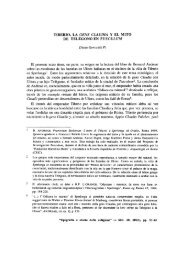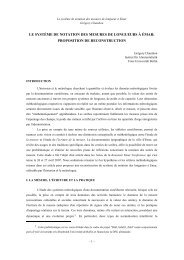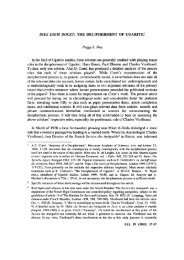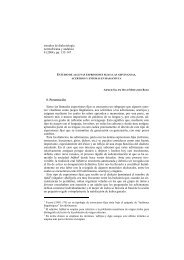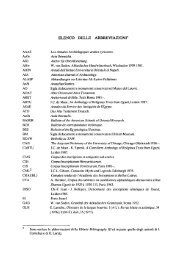estudios de dialectología norteafricana y andalusí 10 - Instituto de ...
estudios de dialectología norteafricana y andalusí 10 - Instituto de ...
estudios de dialectología norteafricana y andalusí 10 - Instituto de ...
Create successful ePaper yourself
Turn your PDF publications into a flip-book with our unique Google optimized e-Paper software.
222 Fe<strong>de</strong>rico Corriente<br />
que ése sea el verda<strong>de</strong>ro étimo, y no siempre dustaw°, como pensó Nykl, <strong>de</strong> algunas<br />
variantes <strong>de</strong> doxtoni y q.v. en n. a p. 366.<br />
p. 456: <strong>de</strong> Vázquez & Herrera 1989:<strong>10</strong>0, hay que insertar tasfid “forma <strong>de</strong> cabeza<br />
como un cesto” < tasf°† (cf. almesefath); el ju<strong>de</strong>o-esp. tasín “cazuela”, q.v., <strong>de</strong>l<br />
étimo neoár. <strong>de</strong> tixela; <strong>de</strong> DAX 1732, tau “última letra <strong>de</strong>l alfabeto hebreo” < hb.<br />
tåw.<br />
p. 457: insertar tau(t) v. atabud, tazmim/n v. atazmim; <strong>de</strong> DAX 1732, tayafin o<br />
tayaquin, nombre <strong>de</strong> cierto medicamento para halcones, podría ser corrupción<br />
mayor <strong>de</strong>l ezteuehiçiri mencionado en adición a p.311, prob. < ár. †abåfi°r; tebegi v.<br />
altebegi; <strong>de</strong> GP 123, tech algeuze < neoár. tåj aljawzå$ “corona <strong>de</strong> Orión”, dicho <strong>de</strong><br />
varias estrellas <strong>de</strong> dicha constelación, según Kunitzsch 1961:112-113; <strong>de</strong><br />
Vázquez&Herrera 1983:179, techaschas “tintineo” < ár. taxafixufi; tehal v. tahal.<br />
p. 458: insertar tejaroz v. algeroz; teilulae y teli/ul v. altialil; <strong>de</strong><br />
Vázquez&Herrera 1989:143, tenchis alras “caída <strong>de</strong> cabeza a<strong>de</strong>lante” < neoár.<br />
tank°s arra$s; teneb v. a<strong>de</strong>lfin y caytoç; ten(n)in o Tennyn v. altannyn; teredins<br />
v. alterhel; <strong>de</strong> Vázquez&Herrera 1989:270, terid “bodrio” < ár. ‡ar°d; el mur.<br />
te(r)niya “telera <strong>de</strong>l arado”, <strong>de</strong> Gómez Ortín 1991, prob. < ár. ‡aniyyah “incisivo”;<br />
terraguillo v. tagarillo; <strong>de</strong> GP 123, teuebi alayoc “seguidores <strong>de</strong> alayoc” < neoár.<br />
tawåbi# al#ayy¤q, i<strong>de</strong>ntificado por Kunitzsch 1961:114 y 36 con Beta, Theta y<br />
Gamma <strong>de</strong>l Auriga; <strong>de</strong> Vázquez&Herrera 1989:271, thabahegiat o thabahegi<br />
“cierto plato” < neoár. †abåhijiyyah < neop. tabåh©e 415 ; thabun y thahaum v.<br />
althaun; tharas v. altharas, th(e)begi v. altebegi, techeregiet v. althecaregi; <strong>de</strong><br />
DAX 1733, thebeth “enero” < hb. tæbæt, thesserin “séptimo mes <strong>de</strong> calendario<br />
hebreo”, forma que no respon<strong>de</strong> al hb. tifiri, sino al sir. o ár. tifir°n; theriaca v.<br />
tyryace; thoehhamie v. althochme; thoraya v. açoraya.<br />
p. 459: añádase en tiraz las var. leo. tiraz/çe y tyrace <strong>de</strong> DO 282, así como el<br />
<strong>de</strong>r. tiracero <strong>de</strong> DO 281-282; tochme y tochamie v. altochme; <strong>de</strong> DAX 1765,<br />
togrín “especie <strong>de</strong> gavilán” < ár. †u@r°l, <strong>de</strong> origen tr., en realidad la hembra <strong>de</strong>l azor<br />
<strong>de</strong>l país <strong>de</strong> los Khazar 416 ; el can. tomaría, var. <strong>de</strong>l pt. tomara; <strong>de</strong> DAX 1772,<br />
tonitoz “cierta piedra”, corrupción <strong>de</strong>l gr. taøœneios “a modo <strong>de</strong> pavo real”.<br />
p. 460: hay que insertar toronia v. taronja; <strong>de</strong> DAX 1776, toriz “piedra<br />
semipreciosa semejante al mármol”, que podría ser lo mismo, a pesar <strong>de</strong> la distinta<br />
<strong>de</strong>finición, que toryn “cristal <strong>de</strong> roca” en DAX 1785, < ár. tabr°z° “<strong>de</strong> Tabriz” (v.<br />
tauris); el hápax leo. toroninio <strong>de</strong> DO 283, <strong>de</strong>l ár. †år¤n° “cierto tejido <strong>de</strong> seda y<br />
lana” 417 ; <strong>de</strong> GP 123, la var. torqui <strong>de</strong> torquy; el mur. trafalla “persona<br />
atolondrada”, <strong>de</strong> Gómez Ortín 1991, posible pariente <strong>de</strong> trafalnejas o <strong>de</strong><br />
esturrufar (q.v.); <strong>de</strong> DAX 1805, treffa, que en ningún modo significa aquí “tísico”,<br />
como indican los autores, sino que es el bien conocido tecnicismo rabínico, hb.<br />
†e&ræpåh “carne mortecina”; trehel v. altherel; <strong>de</strong> Vázquez&Herrera 1989:273,<br />
trifera o triphera “cierto antídoto”: es cuestionable si hay paso por el neoár. i†r°ful,<br />
pues se trata <strong>de</strong>l pl. <strong>de</strong>l gr. tripherón “<strong>de</strong>licado”, y así traduce Ruyzes (cf. atrípulo);<br />
<strong>de</strong> Vázquez&Herrera 1983:179, turmusius “abceso cálido”, <strong>de</strong>l neoár. ∏†rmysws


